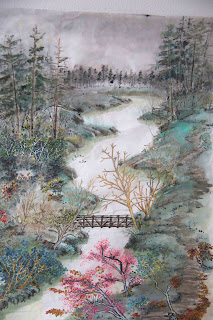The works I choose are usually simple, not elaborate. I can only take in a few things at a time.
I came upon 2 ink wash paintings. My first impression was the paintings had interesting composition. As I examined further into these works, I was intrigued by the ink tones and the soft yet discrete brushstrokes. The lines seemed to be blurry and distinct at the same time.
The first scene included a boat, waters, a hut and hills. A dominant horizontal aspect described by prominent undulating contour lines and light value lines. The circumventing path punctuated with such subdued flair. Neither the boat, nor the hut assumed a main character role, but they answer to each other across the hill, with the hut half hidden by bushes. The riveting bushes showed delicate tips by the ink layering technique. (A different technique and feel was explored in my Playing with Visual Acuity blog )
The second piece showcased a forest hiding a house, with a winding path/stream breaking the vertical lines. The lessons to be learned here was how to handle the different ink tones and building up the branches/leaves to a pleasing form with perspective and attitude. The painting made a deliberate statement about the relative positions of the trees in the foreground. This was however, a more interesting example than the ones shown in the Mustard Seed Garden.
As I completed my emulation exercise, I liked the pieces so much that I researched deeper into them, and I was even more astonished. The works that I emulated were by Gong Xian (1619-1689). Imagine someone in the 17th century China emoting over the natural beauties and was able to depict them in what seemed to be simple paintings. The simplicity was actually cloaked in interesting composition and brush strokes. As it turned out, Gong Xian was credited with being the fore bearer of the Jimo ( accumulating layers of ink ) technique. I am glad that I've at least identified the correct technique to practise on. In fact, do these paintings not look like some of the contemporary works by western artists?
People have honored Simplicity as one of the merits/attributes of Chinese Brush painting, but just as Qi Baishi said with his catfish painting, to emote with a few simple strokes is difficult indeed. Too many professed Chinese brush artists promise to show how to paint a fish or a bird in a few strokes. Whereas the technique might be true, but the path to get there is not.























